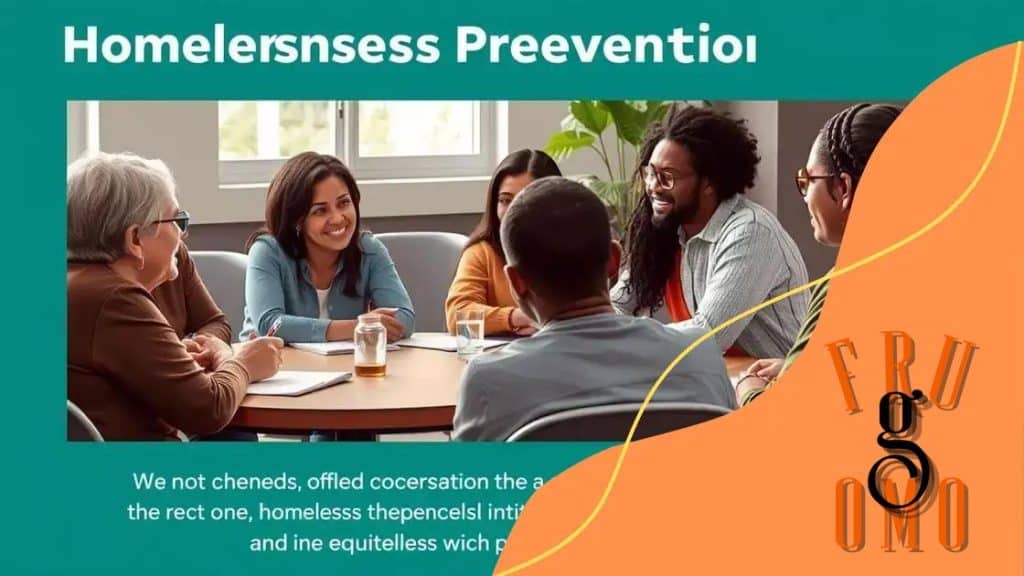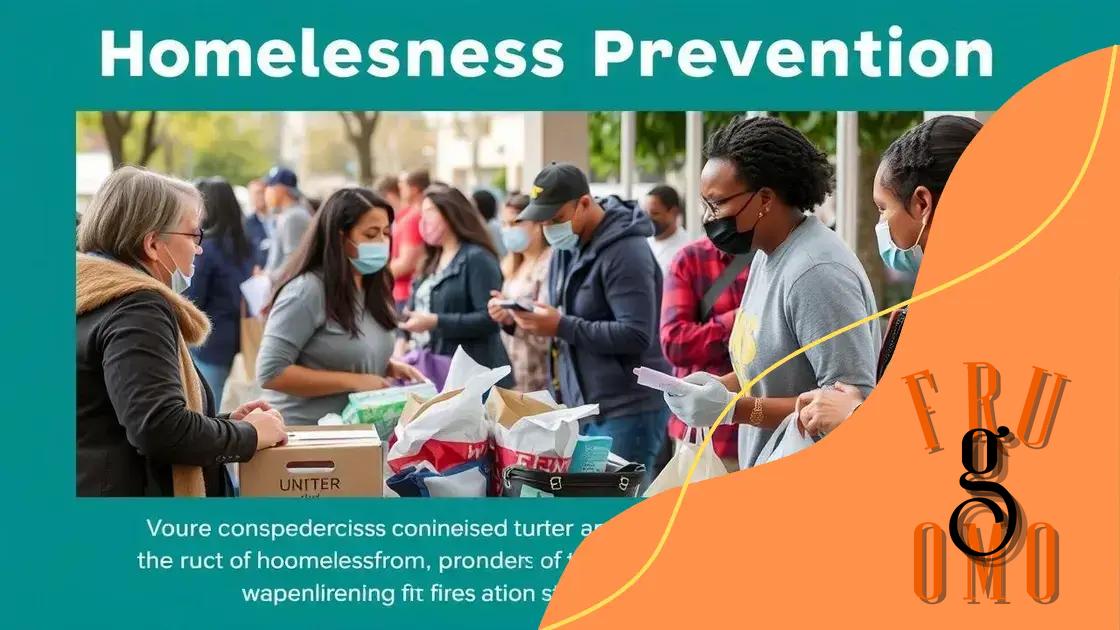Homelessness prevention initiatives: finding effective solutions

Homelessness prevention initiatives are programs designed to support at-risk individuals and families by providing necessary resources, strong government policies, and community involvement to help them maintain stable housing and improve their overall quality of life.
Homelessness prevention initiatives are crucial in tackling the complex issue of homelessness in our communities. Have you ever wondered how these programs can make a difference in people’s lives? In this article, we will delve into the various strategies and collaborative efforts that help prevent homelessness.
Understanding homelessness prevention initiatives
Understanding homelessness prevention initiatives is essential for tackling the complex issue of homelessness effectively. These programs aim to provide support and resources to individuals at risk of losing their homes. By addressing the root causes of homelessness, we can prevent it before it starts.
The Importance of Early Intervention
Preventing homelessness starts with identifying at-risk groups early. Families facing financial difficulties, individuals with mental health issues, or those recently discharged from care facilities can all benefit from timely interventions. Connecting these individuals with resources such as financial aid, counseling, and housing options can significantly reduce their chances of becoming homeless.
Types of Prevention Programs
Various types of homelessness prevention initiatives exist, each tailored to meet specific needs. Here are some common examples:
- Emergency financial assistance
- Ongoing case management
- Rent control and assistance programs
- Wraparound services, including health care and job training
These initiatives often work together to provide comprehensive support to those in need. For example, a family might receive financial aid to cover rent while also accessing counseling services to help them improve their financial literacy.
Community-Based Approaches
Community involvement is a vital aspect of successful homelessness prevention initiatives. Local organizations, volunteers, and government agencies can create a network of support that addresses the unique challenges of their communities. By fostering partnerships, these groups can work together to share resources, knowledge, and strategies.
Additionally, educating the community about homelessness can help reduce stigma. When community members understand the factors that lead to homelessness, they may be more willing to lend their support. This could include advocating for affordable housing or supporting local initiatives designed to prevent homelessness.
By focusing on these aspects and continually adapting initiatives based on community needs, we can create a more resilient infrastructure to combat homelessness effectively.
Key strategies for effective intervention
Key strategies for effective intervention in homelessness prevention are essential for communities looking to make a real difference. Identifying the right methods can significantly impact the lives of those at risk of becoming homeless.
Building Strong Support Systems
One effective strategy is to build strong support systems for those in need. This involves connecting individuals with resources such as mental health services, substance abuse treatment, and job training programs. These services are essential because they provide comprehensive support.
A well-rounded support system will also include:
- Peer mentoring programs
- Access to affordable healthcare
- Financial counseling
- Housing support services
These elements work together to create a safety net, helping to prevent individuals from slipping into homelessness.
Collaboration with Local Organizations
Collaboration is vital. Local organizations can work together to create a more robust response to homelessness. For instance, shelters, food banks, and healthcare providers can share resources and information. This collaborative approach ensures that no one is falling through the cracks.
By pooling resources, each organization can address various aspects of homelessness, maximizing their impact. For example, a shelter might partner with a local mental health clinic to provide on-site services for residents. This can significantly improve the outcomes for those seeking help.
Effective interventions should also focus on prevention education. Teaching individuals and families about financial literacy and available resources can help them avoid homelessness in the first place. By empowering communities with knowledge, we lay the groundwork for lasting change.
Understanding the significance of policy advocacy is another critical aspect. By advocating for policies that support affordable housing and tenant protections, communities can create an environment where homelessness is addressed at its roots.
Community involvement and support

Community involvement and support are vital for the success of homelessness prevention initiatives. When community members engage with local programs, they help build a stronger network of support for those in need. This collective effort can make a significant difference.
The Role of Volunteers
Volunteers play a crucial role in these initiatives. They provide hands-on assistance and help bridge the gap between services and those who need them. By offering their time and skills, volunteers can:
- Create awareness about homelessness in the community.
- Assist in organizing events and fundraising activities.
- Support individuals by providing mentorship or guidance.
- Help with administrative tasks in local shelters or organizations.
These contributions enhance the impact of homelessness prevention initiatives and foster a sense of belonging within the community.
Partnerships with Local Businesses
Another important aspect of community support is the involvement of local businesses. When businesses partner with local organizations, they can sponsor events, donate resources, or provide job training opportunities. Supporting these initiatives often leads to:
- Increased funding for essential programs
- Access to employment opportunities for individuals facing homelessness
- Greater awareness of homelessness-related issues
Additionally, community events such as food drives or workshops create a platform for neighbors to come together and show their support.
Building a culture of empathy and understanding in the neighborhood is also crucial. Hosting awareness campaigns, such as storytelling events, can help educate community members about the challenges faced by individuals experiencing homelessness. Sharing personal stories humanizes the experience and encourages compassion.
Finally, ongoing collaboration among community members, organizations, and local leaders is essential in addressing homelessness effectively. By working together, they can identify shared goals and ensure a united approach to prevention initiatives.
Government policies on homelessness prevention
Government policies on homelessness prevention play a crucial role in shaping the landscape of support for those at risk. By implementing effective policies, governments can provide resources and frameworks that empower local communities to take action.
Understanding Policy Frameworks
Policies aimed at preventing homelessness often focus on several key areas. These include affordable housing initiatives, emergency assistance programs, and supportive services that address the underlying causes of homelessness. For instance, funding for housing first programs ensures individuals have stable housing before receiving additional support.
Some essential components of these policies include:
- Increased funding for affordable housing
- Support for mental health and substance abuse programs
- Legal protections for tenants to prevent eviction
- Access to job training and employment services
These elements work together to create a supportive environment for those at risk of losing their homes.
Impact of National Strategies
Countries with strong national strategies on homelessness prevention show lower rates of homelessness overall. For example, comprehensive national policies often encourage coordination between federal, state, and local efforts. This collaboration helps streamline resources and services, making them more accessible to individuals in need.
Public awareness campaigns funded by government initiatives can also play a significant role. By educating the public about homelessness and how to support prevention efforts, the stigma surrounding homelessness can be reduced.
Furthermore, it is important for governments to track the effectiveness of their policies. Data collection and analysis allow for adjustments to be made when certain strategies are not yielding the desired outcomes. This adaptive approach ensures that resources are used efficiently and that the needs of the community are met.
Local governments can benefit from implementing policies that leverage community partnerships. Collaborating with non-profits, businesses, and other stakeholders creates a robust support network that addresses homelessness comprehensively.
Real-life success stories and lessons learned
Real-life success stories highlight the positive impact of homelessness prevention initiatives. These stories inspire hope and provide valuable insights into what works in the community. By learning from both successes and challenges, we can better shape future efforts.
Success Story: The Housing First Approach
One successful model is the Housing First approach, which prioritizes providing permanent housing to individuals without preconditions. This initiative has shown remarkable results in various cities. For example, in Salt Lake City, Utah, the implementation of this strategy led to a significant decrease in chronic homelessness.
Key outcomes include:
- Lower healthcare costs due to improved stability
- Increased employment rates among participants
- Enhanced quality of life for individuals and families
This story underscores the importance of stable housing as a foundation for recovery and growth.
Lessons Learned from Community Engagement
Another factor in successful homelessness prevention initiatives is community engagement. In Seattle, the partnership between local non-profits and community members led to the development of a robust outreach program. Volunteers collaborated to connect people with resources such as shelter, food, and healthcare.
Lessons learned from this initiative include:
- The need for ongoing training for volunteers
- Understanding the unique challenges of different populations
- Building trust within vulnerable communities
This highlights that community involvement is essential for creating effective strategies to address homelessness.
As these stories show, every initiative can inform future strategies. By analyzing different approaches and understanding their outcomes, communities can create tailored solutions that address their specific needs. In doing so, we also recognize the resilience and strength of individuals who have faced homelessness.
In summary, homelessness prevention initiatives play a vital role in reducing the rate of homelessness in our communities. By understanding effective strategies, leveraging community support, and implementing strong government policies, we can create comprehensive solutions that address this pressing issue. Success stories and lessons learned from various programs show the importance of collaboration and innovative approaches. Together, we can enhance the quality of life for individuals facing homelessness and build a more inclusive society.
FAQ – Frequently Asked Questions about Homelessness Prevention Initiatives
What are homelessness prevention initiatives?
Homelessness prevention initiatives are programs designed to support individuals and families at risk of losing their homes, providing resources and assistance to help them maintain stability.
How can community involvement help prevent homelessness?
Community involvement strengthens support networks, encourages donations and volunteerism, and helps raise awareness about homelessness, making it easier to connect those in need with available resources.
What role do government policies play in preventing homelessness?
Government policies can provide funding and frameworks for affordable housing, mental health support, and other services, which are critical for addressing the root causes of homelessness.
Can you share a success story related to homelessness prevention?
One success story is the Housing First approach, which has effectively reduced chronic homelessness by providing stable housing first, allowing individuals to access support services afterward.





